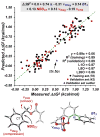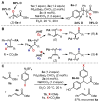Mechanistic Investigations of the Pd(0)-Catalyzed Enantioselective 1,1-Diarylation of Benzyl Acrylates
- PMID: 28800230
- PMCID: PMC5649438
- DOI: 10.1021/jacs.7b06917
Mechanistic Investigations of the Pd(0)-Catalyzed Enantioselective 1,1-Diarylation of Benzyl Acrylates
Abstract
A mechanistic study of the Pd-catalyzed enantioselective 1,1-diarylation of benzyl acrylates that is facilitated by a chiral anion phase transfer (CAPT) process is presented. Kinetic analysis, labeling, competition, and nonlinear effect experiments confirm the hypothesized general mechanism and reveal the role of the phosphate counterion in the CAPT catalysis. The phosphate was found to be involved in the phase transfer step and in the stereoinduction process, as expected, but also in the unproductive reaction that provides the traditional Heck byproduct. Multivariate correlations revealed the CAPT catalyst's structural features, affecting the production of this undesired byproduct, as well as weak interactions responsible for enantioselectivity. Such putative interactions include π-stacking and a CH···O electrostatic attraction between the substrate benzyl moiety and the phosphate. Analysis of the computed density functional theory transition structures for the stereodetermining step of the reaction supports the multivariate model obtained. The presented work provides the first comprehensive study of the combined use of CAPT and transition metal catalysis, setting the foundation for future applications.
Figures










Similar articles
-
Development and Analysis of a Pd(0)-Catalyzed Enantioselective 1,1-Diarylation of Acrylates Enabled by Chiral Anion Phase Transfer.J Am Chem Soc. 2016 Dec 14;138(49):15877-15880. doi: 10.1021/jacs.6b11367. Epub 2016 Nov 30. J Am Chem Soc. 2016. PMID: 27960315 Free PMC article.
-
Transition state analysis of enantioselective Brønsted base catalysis by chiral cyclopropenimines.J Am Chem Soc. 2014 Jul 30;136(30):10700-7. doi: 10.1021/ja504532d. Epub 2014 Jul 16. J Am Chem Soc. 2014. PMID: 25029194 Free PMC article.
-
Enantioselective Intramolecular Allylic Substitution via Synergistic Palladium/Chiral Phosphoric Acid Catalysis: Insight into Stereoinduction through Statistical Modeling.Angew Chem Int Ed Engl. 2020 Aug 17;59(34):14647-14655. doi: 10.1002/anie.202006237. Epub 2020 Jun 30. Angew Chem Int Ed Engl. 2020. PMID: 32453890 Free PMC article.
-
Aromatic π-Components for Enantioselective Heck Reactions and Heck/Anion-Capture Domino Sequences.Acc Chem Res. 2022 Mar 1;55(5):734-745. doi: 10.1021/acs.accounts.1c00781. Epub 2022 Feb 4. Acc Chem Res. 2022. PMID: 35119256
-
Palladium-catalyzed cross coupling reaction of benzyl bromides with diazoesters for stereoselective synthesis of (E)-alpha,beta-diarylacrylates.Org Lett. 2009 Jan 15;11(2):469-72. doi: 10.1021/ol8026076. Org Lett. 2009. PMID: 19099492
Cited by
-
Catalysing (organo-)catalysis: Trends in the application of machine learning to enantioselective organocatalysis.Beilstein J Org Chem. 2024 Sep 10;20:2280-2304. doi: 10.3762/bjoc.20.196. eCollection 2024. Beilstein J Org Chem. 2024. PMID: 39290209 Free PMC article. Review.
-
Harnessing Noncovalent Interactions in Dual-Catalytic Enantioselective Heck-Matsuda Arylation.J Am Chem Soc. 2019 Jan 16;141(2):998-1009. doi: 10.1021/jacs.8b11062. Epub 2018 Dec 28. J Am Chem Soc. 2019. PMID: 30562010 Free PMC article.
-
Design Approaches That Utilize Ionic Interactions to Control Selectivity in Transition Metal Catalysis.Chem Rev. 2025 Mar 12;125(5):2846-2907. doi: 10.1021/acs.chemrev.4c00849. Epub 2025 Feb 28. Chem Rev. 2025. PMID: 40020185 Free PMC article. Review.
-
Studying Noncovalent Interactions in Molecular Systems with Machine Learning.Chem Rev. 2025 Jun 25;125(12):5776-5829. doi: 10.1021/acs.chemrev.4c00893. Epub 2025 Jun 9. Chem Rev. 2025. PMID: 40489661 Free PMC article. Review.
-
Predictive and mechanistic multivariate linear regression models for reaction development.Chem Sci. 2018 Jan 23;9(9):2398-2412. doi: 10.1039/c7sc04679k. eCollection 2018 Mar 7. Chem Sci. 2018. PMID: 29719711 Free PMC article. Review.
References
-
- Jacobsen EN, Yamamoto APH. Comprehensive Asymmetric Catalysis. 1–3 Springer; Berlin: 1999.
-
- Kalyani D, Sanford MS. J Am Chem Soc. 2008;130:2150. - PubMed
- Urkalan KB, Sigman MS. Angew Chem Int Ed. 2009;48:3146. - PMC - PubMed
- Kalyani D, Satterfield AD, Sanford MS. J Am Chem Soc. 2010;132:8419. - PMC - PubMed
- Werner EW, Urkalan KB, Sigman MS. Org Lett. 2010;12:2848. - PMC - PubMed
- Liao L, Jana R, Urkalan KB, Sigman MS. J Am Chem Soc. 2011;133:5784. - PMC - PubMed
- Satterfield AD, Kubota A, Sanford MS. Org Lett. 2011;13:1076. - PMC - PubMed
- Saini V, Sigman MS. J Am Chem Soc. 2012;134:11372. - PMC - PubMed
- Saini V, Liao L, Wang Q, Jana R, Sigman MS. Org Lett. 2013;15:5008. - PMC - PubMed
- He Y, Yang Z, Thornbury RT, Toste FD. J Am Chem Soc. 2015;137:12207. - PMC - PubMed
- Miró J, del Pozo C, Toste FD, Fustero S. Angew Chem Int Ed. 2016;55:9045. - PMC - PubMed
-
- Liao L. PhD Dissertation. University of Utah; Salt Lake City, UT: 2012. Development of palladium-catalyzed difunctionalization reactions of 1,3-dienes and alkenes.
Publication types
MeSH terms
Substances
Grants and funding
LinkOut - more resources
Full Text Sources
Other Literature Sources
Research Materials
Miscellaneous

